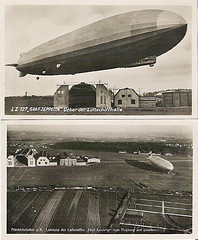 Consider, for a moment, alternate history.
Consider, for a moment, alternate history.
We’re speaking here not of a particular history, but of the genre, the speculative fictions that ask: What if things had been different?
There are many variations on this theme. Perhaps an important event has a different outcome (Persia crushes the upstart poleis of Greece, wiping democracy from the historical stage), or a strange development changes everything (Jean-Marie Jacquard follows up the principles suggested by his earlier invention and creates a general-purpose Ciphering Loom, ushering in a Napoleonic ère de l’information). Quite often, the change selected for the story is a small one, and the interest is in working out the complex ways that things might change further down the time-stream. (For encyclopedic, alternately-historical fun, check out Uchronia or the bite-sized glimpses into nearby universes dished out at Today in Alternate History).
Perhaps these phantasies are more science fiction than one might think at first: in the July 2 issue of Nature, Peter Turchin writes (behind a paywall, unfortunately):
…[W]e need a historical social science, because processes that operate over long timescales can affect the health of societies. It is time for history to become an analytical, and even a predictive, science…Rather than trying to reform the historical profession, perhaps we need an entirely new discipline: theoretical historical social science. We could call this ‘cliodynamics’, from Clio, the muse of history, and dynamics, the study of temporally varying processes and the search for causal mechanisms
Shades of Asimov’s psychohistory!
Ken Hite, in his Suppressed Transmission column, often writes of Clio and alternate histories. (In fact, I suspect that a search of his essays might turn up a prior coining of the term ‘cliodynamics’.) In “An Alternate-Historical Alphabet”, he propounds the following theory:
All Change Points (q.v.) from Xerxes (q.v.) to the last presidential election, create worlds with clean, efficient Zeppelin traffic. Changing history may produce Zeppelins as an inevitable by-product, much as bombarding uranium produces gamma rays. Often, the quickest way to tell if you are in an Alternate History is to look up, rather than at a newspaper or encyclopedia. From this premise, it is not outside the realm of Plausibility (q.v.) that our history between 1900 and 1936 was, in fact, an Alternate History. It would, at least, explain a lot.
With this in mind, how are we to interpret this recent New York Times story?
As the cost of fuel soars and the pressure mounts to reduce carbon dioxide emissions, several schemes for a new generation of airship are being considered by governments and private companies…[B]ecause of new materials and sophisticated means of propulsion, a diverse cast of entrepreneurs is taking another look at the behemoths of the air.
Clearly, these are parlous times, and the cold, hard light of Science reveals a looming Change Point.
Watch the skies!
“Arise, Cliodynamics!” article via Complexity Digest
Zeppelin article via Gizmodo.
Image of a Zeppelin-Luftschiff LZ 127 courtesy Schockwellenreiter.